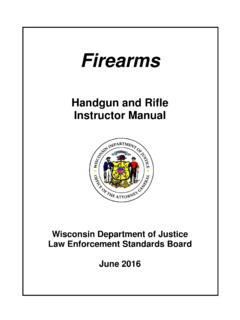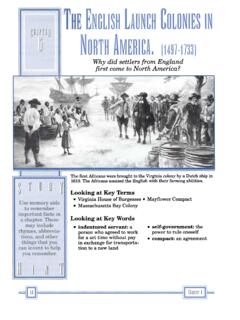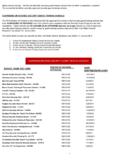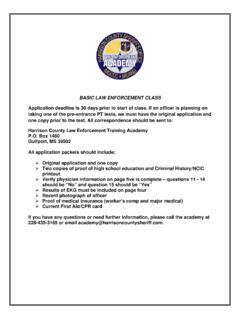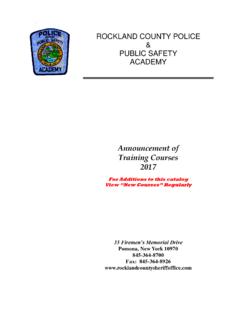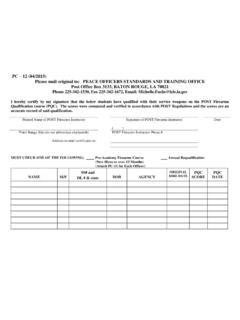Transcription of MILWAUKEE AREA TECHNICAL COLLEGE - ecampus.matc.edu
1 1 MILWAUKEE AREA TECHNICAL COLLEGE Course Syllabus Winter 2019 (Updated 09/28/18) Course: Pistol and Rifle Instructor Credits: Subject Abbreviation: Police Course Number: 426 Section Number: 400 Class Meets: Monday, January 7 to Friday, January 11, 2019 AND Monday, January 14 and Tuesday, January 15, 2019 (7 Days Total) 8:00AM 4:30PM Room A130 and MATC Firearms Range Instructors: James Dailey Sam Lenda Contact Information: 414-530-4850 (cell) 414-571-4704 )work) 414-899-3516 (cell) Course Description: This course is designed to meet the State of Wisconsin guidelines to certify law enforcement officers as a Handgun and Rifle Instructor. Course Goals: The goal of this course is to teach and to certify police officers to become Handgun and Rifle instructors. Course Objectives: By the completion of this course, the student firearms instructor will be able to: 1. Describe in detail, the firearms proficiency requirements for a law enforcement recruit officer to become certified (or certifiable) in Wisconsin.
2 2. Understand the legal basis and limitations on the use of deadly force, deadly force decision-making. 3. Understand the legal limitations and liability issues involved in firearms instruction. 4. Describe the specific competencies and performance objectives in the DOJ-LESB Firearms Instructor Manual - training Guide for Law Enforcement Officers. 5. Understand the concepts of teaching psychomotor skills as applied to the fundamentals of firearms shooting. 6. Develop and conduct safe firearms training . 7. Evaluate student proficiency and remediate deficiencies as required. MILWAUKEE AREA TECHNICAL COLLEGE Course Syllabus Winter 2019 Page 02 Prerequisites: Certified police officer DOJ-LESB Instructor Development Course (IDC) Required Equipment: Wisconsin DOJ-LESB Firearms Instructor Manual LESB firearms training Guide for Law Enforcement Officers firearm and personal duty equipment Ballistic body armor 500 rounds of ammunition Three-ring binder, paper, writing instruments Hearing and eye protection (provided by MATC) Required Personnel: Two LESB certified Firearms Master Instructors Trainers (MIT) Source Documentation and Texts: WI Dept.
3 Of Justice: training and Standards Bureau. Firearms: A training Guide for Law Enforcement Officers. Edition: June 2017 WI Dept. of Justice: training and Standards Bureau. Firearms Instructor Manual. Edition: December 2014 WI Dept. of Justice: training and Standards Bureau. Firearms Instructor Course, Instructor Manual, December 2014 WI Dept. of Justice: training and Standards Bureau. Firearms Administrative Guide, December 2010 Course Competencies: See attached DOJ-LESB Lesson Plan Course Calendar: See attached Block Plan Attendance Policy: Must attend all 7 days of training MILWAUKEE Area TECHNICAL COLLEGE Pistol and Rifle Instructor Course Police 426 - 400. Winter 2019 COURSE SCHEDULE Hours Lesson Plan Topic(s) Notes DAY ONE: Monday, January 7 1 Session 1 Welcome and Introductions Course Overview Pre-Course Evaluations (pre-completed Skills Competency Checklist) Classroom Explain course outline, lesson plans, and expectations.
4 Emphasis this is an instructor level course and not a shooting / tactical course. 2 Session 2 Instructor Responsibilities Classroom 3 Session 3 The Firearms Basic Course Curriculum Classroom *include new course of fire / competencies for recruits 4 Session 4 Decision Making Legal Context Surrounding Deadly Force Classroom 5 6 Session 5 Practice Teaching Assignments Classroom IDC Review Lesson Plans and Syllabus PPT 7 Session 6 Safety Procedures for Classroom, Scenario, and Live-Fire Environments Classroom / Range Walk through Simulation training Triple Checks Wellness Checks checklist 8 Session 7 Teaching Care and Use of Firearms Classroom Teaching Phase I Range and Range Classroom DAY TWO: Tuesday, January 8 9 Session 4 Pop Quiz Deadly Force Decision Making and Legal Context Classroom / Review / Safety Briefing 10 Session 8 Plan and Manage a Firing Range Range Range management practice drills. Range commands 11 12 Session 9 Correcting Common Student Errors Range 13 14 15 16 MILWAUKEE Area TECHNICAL COLLEGE Pistol and Rifle Instructor Course Police 426 - 400.
5 Winter 2019 DAY THREE: Wednesday, January 9 17 Session 9 (continued) Teaching Shooting Fundamentals and Correcting Common Student Errors (continued) Range Teaching Phase II 18 19 20 21 22 23 24 DAY FOUR: Thursday, January 10 25 Session 10 Instructor Candidate Practice Teaching Presentations (Handgun) Range Each Instructor Candidate will have 30 minutes plus 10 minutes for prep-time to conduct their Handgun Teaching Assignment. 26 27 28 29 30 31 32 DAY FIVE: Friday, January 11 33 Session 11 Teaching Rifle Classroom Topics Classroom 34 35 Session 12 Teaching Rifle Fundamentals Range 36 37 38 29 40 MILWAUKEE Area TECHNICAL COLLEGE Pistol and Rifle Instructor Course Police 426 - 400. Winter, 2019 DAY SIX: Monday, January 14 41 Session 12 (continued) Teaching Rifle Fundamentals (continued) Range 42 43 44 45 46 47 48 DAY SEVEN: Tuesday, January 15 49 Session 13 Instructor Candidate Practice Teaching Presentations (Rifle) Range Each Instructor Candidate will have 20 minutes plus 10 minutes for prep-time to conduct their Rifle Teaching Assignment.
6 50 51 52 53 54 55 Session 14 Course Conclusion Classroom 56 This schedule may be adapted at the discretion of the course instructor. Mandatory PAT and Experiential Exercises are non-discretionary. Firearms Instructor Course DOJ - LESB Syllabus Course Description This course prepares Wisconsin Law Enforcement Standards Board (LESB) certified officers to effectively administer and teach the firearms training program. This course emphasizes teaching and learning techniques that promote active learning, support learners with a variety of learning preferences and needs, and generate continuous improvements in teaching and learning. The goal of this program is to prepare certified officers who are proficient in using firearms to deliver LESB-approved firearms curriculum. Competencies and Learning Objectives 1. Identify the expectations of the firearms instructor training program. * Learning objectives What you will learn as you master the competency: Complete the pre-test session.
7 Introduce yourself and express expectations of this training program. Become familiar with the course location and surroundings. Become familiar with the course objectives and activities. 2. Identify instructor responsibilities. Learning objectives What you will learn as you master the competency: Describe instructor certification requirements. Describe the instructor certification and re-certification processes. Identify the teaching requirements to remain certified as an instructor. Describe what constitutes training for instructor re-certification purposes. Explain the documents that must be completed at the end of a firearms instructor course. 3. Describe the components of the Firearms Basic Course curriculum packet (orientation to course materials). Learning objectives What you will learn as you master the competency: Describe the documents that make up the standard curriculum packet. Describe the content and format of the lesson plans for the firearms basic course.
8 Describe each session of the firearms basic course. Identify the completion requirements for the firearms basic course. Identify the instructor requirements for documenting completion of the firearms basic course. 4. Review decision-making and legal issues surrounding use of force decisions. Learning objectives What you will learn as you master the competency: Describe how to make appropriate deadly-force decisions. Explain the basis for use of force and limitations of that use of force. Review legal issues for criminal and civil liability for intentional and/or negligent acts. 5. Prepare the firearms instructor candidate teaching assignment. Learning objectives What you will learn as you master the competency: Review your assignment for teaching two sections of the firearms basic course (one in the classroom and one on the firing range). Prepare the teaching assignments by reviewing the lesson plan and visual aids used to teach your topics.
9 6. Demonstrate proper safety, use, and care of firearms. Learning objectives What you will learn as you master the competency: Exhibit good weapon handling techniques. Demonstrate proper use, care, and maintenance of a firearm and its associated equipment. 7. Describe safety procedures for classroom and live-fire environments. Learning objectives What you will learn as you master the competency: Review safety guidelines for using firearms during training . Review the key responsibilities of the Officer in Charge (OIC) and training Safety Officer (TSO) when using firearms during training . Review the Personal Protection Equipment (PPE) used in firearms training . Describe the advanced planning tasks needed to run training that includes firearms. Identify steps to prepare students for using firearms during training in classroom and live-fire environments. Describe how to plan and manage firearms training in the classroom and live-fire environments.
10 8. Describe how to safely run a live firearms range. Learning objectives What you will learn as you master the competency: Review general firearms safety rules. Review how to store firearms in a safe manner. Describe how to plan and manage a live firearms range. Describe the advanced planning tasks needed to run a firearms range. Identify steps to prepare the students for the firing range. Describe how to assign sufficient support personnel and determine supplies needed to run a firing range. Identify how to control the firing range and evaluate students firing on the range. 9. Demonstrate how to teach shooting fundamentals and correct student errors. Learning objectives What you will learn as you master the competency: Review basic fundamentals of shooting focusing on common student errors and how to correct them. Review how to teach and observe proper grip and stance for shooting fundamentals focusing on common student errors and how to correct them.
